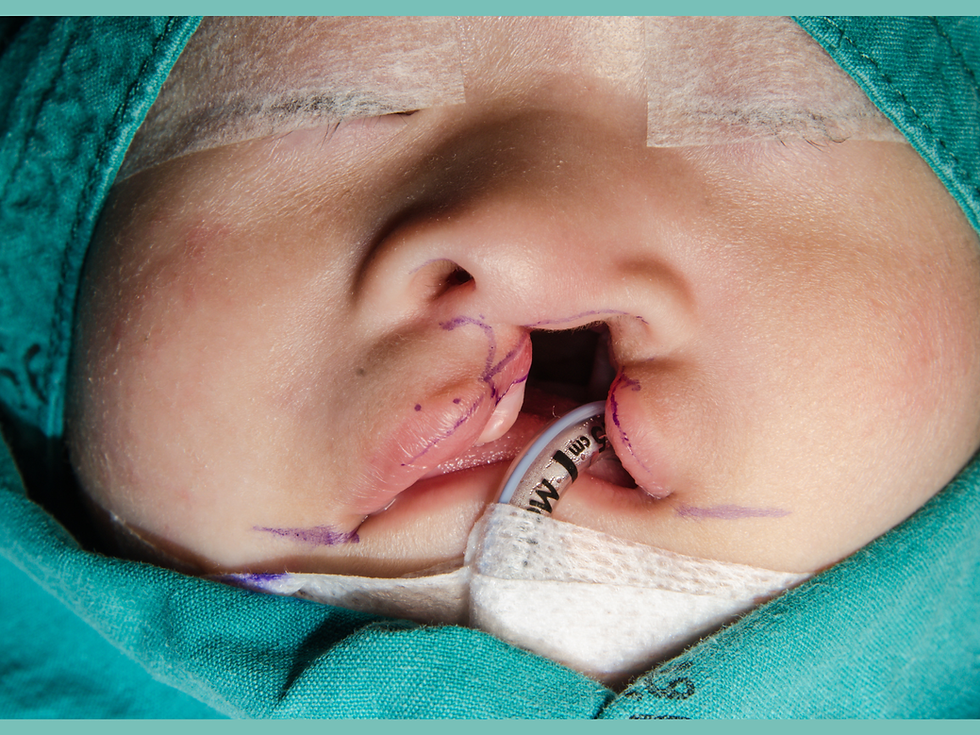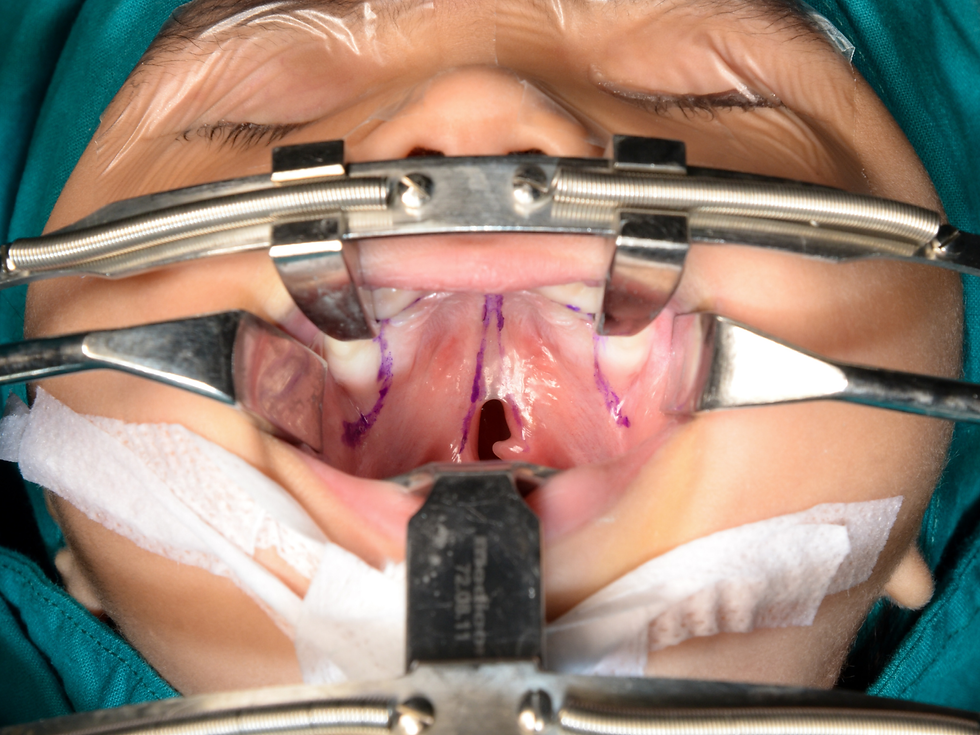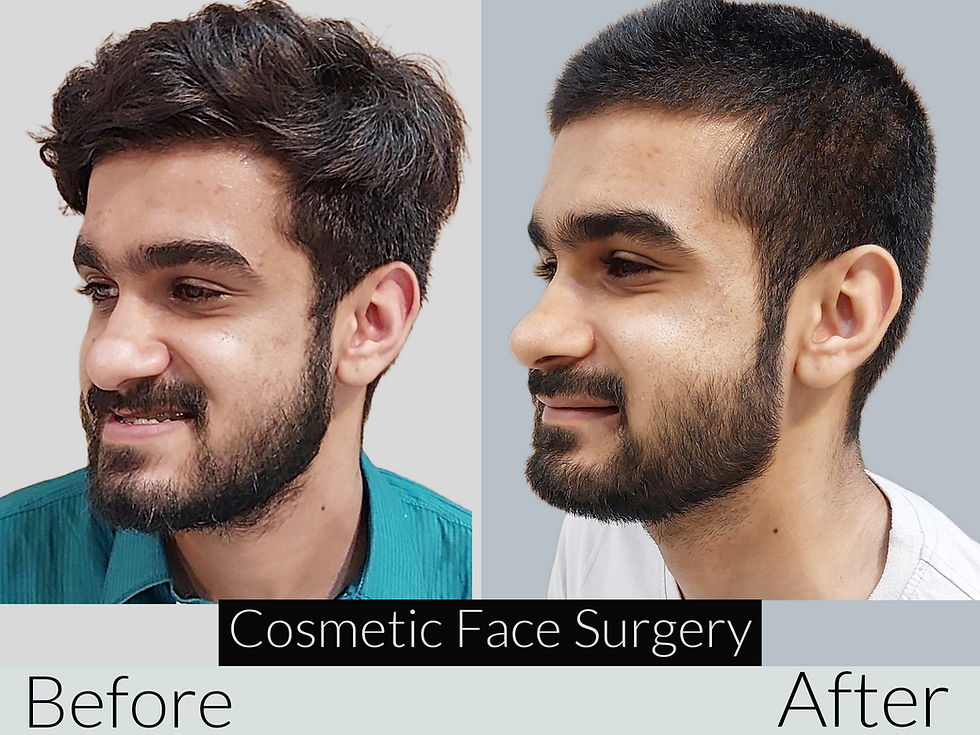A Comprehensive Guide to Cleft Lip and Palate Care for Your Little Warrior
- Aldaim Dental Center
- Nov 9, 2023
- 8 min read
Updated: Aug 11, 2024

Table of content
Understanding the Initial Concerns of Parents
Importance of Timely and Comprehensive Care
Naso-Alveolar Molding: Shaping the Future
Cleft Lip Repair: The Rule of 10
Cleft Palate Repair: Ensuring Uninterrupted Speech
Palatal Expansion: Unlocking the Jaw's Potential
Alveolar Bone Grafting: Bridging Gaps for Tooth Eruption
Orthodontic Treatment (Braces): A Smile Makeover
Orthognathic Surgery: Correcting Jaw Alignment
Rhinoplasty: Enhancing Facial Harmony
Surgery for Velopharyngeal Insufficiency (VPI): Improving Speech Clarity
Emotional Impact on Parents
Addressing Feeding, Swallowing, and Breathing Challenges
The Role of Speech Therapy
Holistic Care for a Healthy Life
Empowering Parents with Knowledge
Looking Ahead: A Bright Future for Cleft Patients
Introduction:
Welcoming a newborn is a joyous occasion, but when faced with the news of a cleft lip or palate, parents may experience a range of emotions.
This article, authored by our esteemed Board-Certified Oral and Maxillofacial Surgeon, Dr. Tauseef Ahmad, serves as a beacon of information, guiding parents through the stages of treatment and beyond.
Understanding the Initial Concerns of Parents
The moment parents learn of their child's cleft condition, it often ushers in a wave of concerns and questions. The emotional impact can be profound. This section delves into the common worries and anxieties experienced by parents, offering insights and reassurance. By acknowledging these concerns, we aim to provide a supportive foundation for parents embarking on this unique journey.
Importance of Timely and Comprehensive Care
Timely and comprehensive care is paramount in the cleft care journey. Delving into why early intervention matters, we explore the critical role of each treatment stage. This includes not only the physical aspects of surgery but also the broader spectrum of emotional and developmental considerations. The article emphasizes the importance of a holistic approach, ensuring that every child receives the individualized care they need at the right stages of their development.
Meet Dr. Tauseef Ahmad: Leading Expert in Oral & Maxillofacial Surgery
At Aldaim Dental Center, we are proud to have Dr. Tauseef Ahmad at the helm, bringing not only his expertise as one of the best among top Oral and Maxillofacial Surgeons in Pakistan, but also a wealth of experience in facial plastics gained through foreign training. Dr. Tauseef Ahmad is renowned for his dedication to addressing complex cases involving teeth, jaws, and facial structures.
Why Choose Aldaim Dental Center:
Expertise: Dr. Tauseef Ahmad's extensive experience uniquely positions Aldaim Dental Center as a hub for resolving intricate cases with compassion and skill.
Comprehensive Care: With a focus on providing holistic care, our clinic goes beyond surgical interventions, ensuring the emotional well-being of both parents and patients.
Tailored Care: Recognizing that not every cleft child requires the same treatment journey, Dr. Tauseef Ahmad customizes care plans based on individual needs
Simplified or Comprehensive Plans: A child with a cleft lip only may have a simpler, shorter treatment journey compared to one presenting with both cleft lip and palate.
Commitment to Better Lives: Dr. Tauseef Ahmad courageously takes on challenging cases, aiming not just to alleviate suffering but to empower individuals to lead healthier, more fulfilling lives.
As the author of this article, Dr. Tauseef Ahmad combines medical insight with a passion for helping families navigate the complexities of cleft lip and palate care. We invite you to explore the comprehensive and compassionate care that sets Aldaim Dental Center apart.
Understanding Clefts: Simplifying for Everyone
In simple terms, a cleft lip is a condition when there's a cut or gap or separation in the upper lip, disrupting its smooth continuation. On the other hand, a cleft palate occurs when there's an opening in the roof of the mouth, potentially allowing food to enter the nasal passage during feeding. Think of these conditions as variations in the natural development of the face and mouth before birth.
Recognizing the Diversity of Clefts
It's crucial to understand that not all clefts are alike. They vary in the extent of structures involved and the severity of the condition. Some may have a cleft lip only, some a cleft palate, and others both. Additionally, the location and size of the cleft can differ; for instance, some may have it on one side, while others have it on both.

The Journey Begins: Treatment Stages for Cleft Lip and Palate
Naso-Alveolar Molding: Shaping the Future
In the initial stages of life, child may be introduced a transformative process known as Naso-Alveolar Molding (NAM), a non-surgical technique that assumes a pivotal role in shaping the future facial structures of your little one. This method employs specialized tapings and elastic rubber bands to delicately mold and align the nose, lips, and the excessively protruding central portion of the upper jaw bone covered by gum tissue.
The primary goal of Naso-Alveolar Molding (NAM) is to prepare these affected areas for subsequent surgical interventions, laying the foundation for a more natural and aesthetically pleasing outcome. Initiated shortly after birth, Naso-Alveolar Molding (NAM) utilizes the innate growth potential of your baby's facial structures, ensuring a tailored and effective approach to their unique needs.
Cleft Lip Repair: The Rule of 10
Around 3 to 6 months of age, cleft lip repair is undertaken, following the Rule of 10: the baby's age should be at least 10 weeks, weighing at least 10 pounds, and with a minimum hemoglobin level of 10 mg/dL. This early intervention not only addresses the visible aspect of the condition but also sets the stage for better feeding, essential for the infant's growth and development.
Cleft Palate Repair: Ensuring Uninterrupted Speech
Cleft palate repair typically occurs between 18 to 24 months of age, allowing for natural palate growth. Performing this surgery before the child begins speaking is crucial to ensure that speech development progresses without interruption. Repairing the cleft at this stage minimizes potential speech issues and supports the child's ability to communicate effectively.
Palatal Expansion: Unlocking the Jaw's Potential
Between 5 to 7 years of age, palatal expansion comes into play. Surgical repair of the palate can lead to scarring, restricting the natural growth of the upper jaw. Palatal expansion, achieved through an appliance, helps align the upper jaw with the lower jaw, promoting proper development and preventing potential dental issues.
Alveolar Bone Grafting: Bridging Gaps for Tooth Eruption
Around 7 to 9 years of age, alveolar bone grafting may be recommended. This procedure addresses clefts extending onto the alveolus, the part of the jaw where teeth erupt. It aims to close gaps before the eruption of specific teeth, ensuring a solid foundation for future dental health.
Orthodontic Treatment (Braces): A Smile Makeover
Invariably required for many cleft patients, orthodontic treatment, often involving braces, is implemented to align twisted or mal-positioned teeth. This step, usually in the teenage years, not only enhances the smile but also sets the stage for the next phase of comprehensive treatment: orthognathic surgery.
Orthognathic Surgery: Correcting Jaw Alignment
As we approach the age of skeletal maturity or post-puberty, typically after 16 years, the strategic planning of orthognathic surgery comes into focus. This specialized cosmetic surgery of the face is designed to address discrepancies in the size, shape, and position of the jaw bone.
For individuals who have undergone previous surgical repair of a cleft palate, a common issue arises: the upper jaw bone, due to post surgical scaring, may be constrained and fail to grow forward adequately. Orthognathic surgery is a meticulous procedure performed to reposition the upper jaw, rectifying these limitations.
By ensuring that the upper jaw aligns well with the lower jaw, this surgery not only contributes to functional alignment but also significantly enhances the aesthetic balance of the entire face. It's a transformative step towards achieving a harmonious and natural facial profile
Rhinoplasty: Enhancing Facial Harmony
Typically scheduled after the age of 17, rhinoplasty addresses cosmetic concerns related to the nose. This surgery contributes to optimal facial aesthetics, an essential aspect of holistic care for cleft patients as they transition into adulthood.
Surgery for Velopharyngeal Insufficiency (VPI): Improving Speech Clarity
Interventions to correct velopharyngeal insufficiency, which contributes to hypernasal speech, may be performed in the early years of life or, in some cases, alongside rhinoplasty. This ensures not only a more natural-sounding speech but also addresses any lingering issues in conjunction with cosmetic nose surgery.
This comprehensive treatment journey, personalized to each patient, reflects our commitment at Aldaim Dental Center to crafting individualized, effective care that respects the uniqueness of each case.

Beyond Surgeries: Nurturing Overall Well-being
Exploring the journey beyond surgeries is pivotal for the holistic well-being of both the child and the parents. This section delves into various aspects that extend beyond the operating room, offering general insights into comprehensive care.
Emotional Impact on Parents
Learning that a child has a cleft condition can evoke a spectrum of emotions for parents. From initial shock to the journey of acceptance, it's essential to acknowledge and address these emotions. Seeking support, whether through local support groups, counseling, or online resources, can play a crucial role in navigating these emotional challenges.
Addressing Feeding, Swallowing, and Breathing Challenges
Cleft conditions may present challenges in feeding, swallowing, and breathing. Understanding these challenges is the first step. Local pediatricians, feeding specialists, and respiratory therapists can provide valuable guidance. Simple adjustments in feeding techniques and monitoring respiratory health can make a significant difference.
The Role of Speech Therapy
Early intervention with speech therapy is paramount for addressing speech challenges. Local speech therapists and early intervention programs can provide valuable assistance. Regular sessions focusing on speech development can greatly enhance a child's communication skills, irrespective of geographical locations.
Holistic Care for a Healthy Life
Taking a holistic approach to care is essential for a child's overall well-being. This includes considerations for their psychological health, social development, and general quality of life. Local healthcare providers, including pediatricians and child development specialists, can assist in developing a comprehensive care plan tailored to the unique needs of the child.
This section underscores the importance of a universal approach to cleft care, recognizing that guidance and support can come from a variety of sources. It aims to empower parents, caregivers, and individuals globally with general insights to navigate the broader aspects of care beyond surgical interventions.
Conclusion:
As we bring this informative journey to a close, our aim is twofold: to empower parents with the knowledge they need and to shine a light on the bright future that awaits cleft patients.
Empowering Parents with Knowledge
Knowledge becomes a powerful ally in the journey through cleft conditions. This subsection emphasizes the importance of ongoing education and open communication between parents and healthcare providers. By providing resources and insights, we strive to equip parents with the tools they need to make informed decisions and offer unwavering support to their children.
Looking Ahead: A Bright Future for Cleft Patients
In this closing section, our focus is on looking forward with optimism. A cleft condition doesn't define a child's future. Advances in medical science, coupled with timely and comprehensive care, pave the way for a promising tomorrow. We encourage parents to envision a future where their child not only copes but thrives—socially, academically, and emotionally. By offering reassurance and highlighting the potential for a vibrant and fulfilling life, we aim to instill hope in every parent's heart.

In conclusion, this article serves as a guidebook for parents, offering insights into how to navigate the journey of cleft care. The intent is to assure them that cleft conditions are treatable, and with comprehensive care at the right time, individuals with clefts can lead rich, fulfilling lives. As you embark on this path, may you find the strength, knowledge, and assurance needed to guide your child toward a future filled with possibilities.



Comments